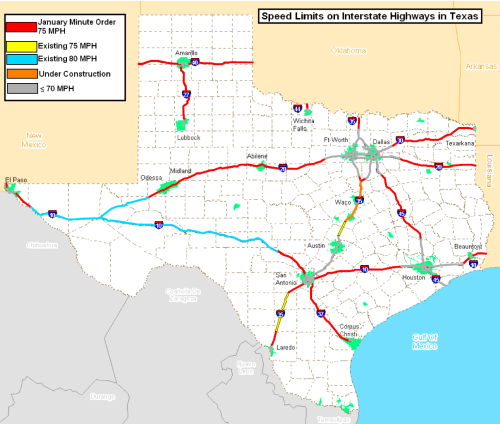DRIVING TIP #4: Don’t drive with your disabled placard on your mirror
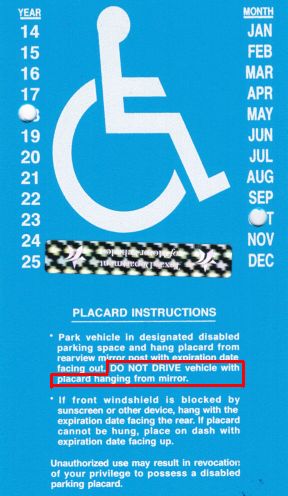 How often do you see someone driving around with the big, blue (or sometimes red) disabled parking placard hanging from their rearview mirror? If you’re like me, probably all the time.
How often do you see someone driving around with the big, blue (or sometimes red) disabled parking placard hanging from their rearview mirror? If you’re like me, probably all the time.
If you’re one of those people doing that, then you’re doing it wrong.
Besides the fact that it explicitly says “DO NOT DRIVE vehicle with placard hanging from mirror” in the instructions on the back of the permit (yes, you’re supposed to take the time to read those words there), and although it’s not specifically illegal, it should be common sense that leaving something that big on your mirror while driving blocks a non-trivial portion of your field of vision, an inherently dangerous proposition. Admittedly, it’s maybe 10% or so of your view, but something could be in that area that makes all the difference, so why take that chance? It only takes a couple of seconds to take it down from your mirror before driving and put it back up there when you park in a reserved spot.
Automobiles Laws and policies Safety: Driving tips
by Brian
Comments Off on DRIVING TIP #3: Wait in the intersection to turn left
DRIVING TIP #3: Wait in the intersection to turn left
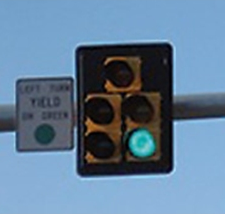 In my previous tip, I discussed not blocking intersections. Today, I’ll discuss a time when it’s okay to wait in the intersection.
In my previous tip, I discussed not blocking intersections. Today, I’ll discuss a time when it’s okay to wait in the intersection.
Sometimes you’ll come to an intersection where you want to turn left and there’s a flashing yellow arrow or a circular green signal but no green arrow at the time you want to turn. In this situation, I usually see people dutifully wait behind the stop line. Then the light turns red and they’re still sitting there. Even worse are intersections that don’t have a protected left arrow at all– I’ve seen people wait behind the line through multiple cycles because oncoming traffic is too heavy to allow them to turn. Occasionally they’ll even give up.
Instead of waiting behind the line, the best thing to do if you need to wait to turn left is to move part of the way into the intersection and wait there. Then, if the light turns red before you’re able to turn, the oncoming traffic will stop and you can complete your turn.
Automobiles Laws and policies Safety: Driving tips
by Brian
Comments Off on DRIVING TIP #2: Don’t block the box!
DRIVING TIP #2: Don’t block the box!
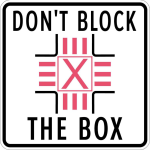 This week, San Antonio police began targeted enforcement of the state’s law against stopping in an intersection. The stepped-up enforcement is part of a pilot project called “don’t block the box”, where the “box” is the intersection and adjacent crosswalks. The program is modeled on similar programs in other cities. Ten problematic intersections all over San Antonio are part of this pilot project and have had signs like the one shown here installed. (Understand, though, that the law applies to all intersections, not just those marked with signs.) This is a statewide problem, so keep reading even if you’re not in San Antonio.
This week, San Antonio police began targeted enforcement of the state’s law against stopping in an intersection. The stepped-up enforcement is part of a pilot project called “don’t block the box”, where the “box” is the intersection and adjacent crosswalks. The program is modeled on similar programs in other cities. Ten problematic intersections all over San Antonio are part of this pilot project and have had signs like the one shown here installed. (Understand, though, that the law applies to all intersections, not just those marked with signs.) This is a statewide problem, so keep reading even if you’re not in San Antonio.
Automobiles Laws and policies Safety: Driving tips
by Brian
Comments Off on DRIVING TIP #1: Scan the road
DRIVING TIP #1: Scan the road
For this first bite-sized driving tip, I’m picking a topic that’s not even discussed on my Texas traffic laws page— scan the road.
Driving down the right lane of a major street recently, I crested the top of a hill and immediately saw a stalled truck in my lane nearly a mile down the road. Traffic in both lanes was light enough to easily change lanes, so I moved to the left lane as soon as I saw the hazard. There were two other cars traveling in the right lane ahead of me and BOTH of them continued down the lane until they were nearly on top of the broken-down truck. At that point, they had to hit their brakes and make a sudden lane change to avoid hitting it.
“WTF? Are these people blind?”
Automobiles Laws and policies Safety: Driving tips
by Brian
Comments Off on Driving tips coming soon
Driving tips coming soon
The top-viewed page on my website texashighwayman.com is consistently the page on Texas traffic laws. It’s obviously a topic lots of folks are interested in. And from what I’ve seen on the roads, lots more folks need to look at it. 🙂
While that page was initially intended to highlight common questions folks have, it’s become quite comprehensive over the years. If you take the time to read the whole thing, it’ll take you while and you’ll feel like you’ve been drinking from a fire hose. So, I’ve decided to parcel-out some of the topics from that page in smaller doses here over the next few months, along with some additional tips that aren’t covered on that other page.
If you’re interested, I’ll announce postings on my Twitter and Facebook pages or just check back here periodically.
Until then, drive safely!
more »
Data visualizations Laws and policies
by ptdriscoll
Comments Off on What drives income inequality?
What drives income inequality?
If we agree that too much wealth in the hands of too few stymies the economy, and even democracy, what do we do?
With the middle class losing ground despite healthy corporate profits, politicians and pundits gladly harp on tax rates, migrant populations and other soft targets to prescribe solutions for growing income disparities.
I decided to see what the data says.
Using World Bank datasets, I analyzed more than a dozen factors to see how they might relate to income distribution, defined here as share of income held by a country’s top 10 percent of earners.
Data visualizations Gas taxes Laws and policies Roads Transit
by Patrick
Comments Off on Texas drivers help pay tab for roads in other states
Texas drivers help pay tab for roads in other states
When you look at how much Texas drivers hand over to Washington and how much comes back, it’s easy to feel like the feds don’t like us much.
Federal officials do not “directly” return a whopping 78 percent of fuel and vehicle taxes collected in Texas. That’s second highest among states; behind Iowa with its 84% bye-bye rate and well ahead of third-place Florida.
Unfortunately, though, there’s a bigger untold story here. Officials invested more than half of those collections into projects straddling one or more states. And the data doesn’t show how those amounts were distributed among states.
So the 78% no-return likely isn’t as bad as it looks. Texas probably received more. Still, hover over the interactive map above and you’ll see a wide range of give and take, including Alaska’s 60 percent gain.
The data, from fiscal 2011, is the latest from the Federal Highway Administration. I saved it to a CSV file and used D3.js, with an assist from ColorBrewer.js and some custom javascript, to display it here. Have fun.
Paying too much for car insurance?
If you’re in Texas, odds are you’re paying more for car insurance than the average U.S. driver, says a survey by Insure.com.
I ran the survey’s data through Google Fusion Tables to see a bigger picture, and it turns out costs are as varied as the nation’s landscape itself. In particular, extreme highs touch all three coasts as well as the Canadian and Mexican borders.
Hover over states to see average costs. The darker the shade, the higher the cost.
Reasons for the undulating costs are, literally, all over the map, from claim-happy and disaster-prone Louisiana and bumper-to-bumper traffic in Georgia, to slow-poke drivers in Iowa and strict teen-driving laws in Maine, according to Insure.com.
The survey looked at 2013 cars and settled on a typical guy with a clean record and good credit. Texas rolled in at $1,545, ranking 19th overall.
Texas joined 19 other states and D.C. to rank higher than the $1,510 national average. Louisiana tops the list with $2,699. Maine sits at the bottom with $934.
Here are the top 10. Again, use hover to see dollars. The full table’s here.
Laws and policies Roads Safety: Speed limits Texas Department of Transportation
by Brian
4 comments
75 mph coming to SA area Interstates!
The Texas Transportation Commission approved increasing the speed limit to 75 mph on about 1,500 miles of mostly-rural Interstate highways in the state. Around the San Antonio area, the following stretches will see 75 mph signs soon:
- I-10 West from Loop 1604 to past Kerrville (where it’s already 80 mph)
- I-10 East from just outside Loop 410 to Waller County west of Houston
- I-35 South from Palo Alto Rd. to the existing 75 mph section south of Devine
- I-37 from just inside Loop 410 to Corpus Christi
I-35 between San Antonio and Austin was not approved for the higher speed limit.
The Legislature approved the higher speed limits last year.
More information
- TxDOT’s 75 mph page – http://www.txdot.gov/safety/speed_limit/75mph.htm
Speed limits going up
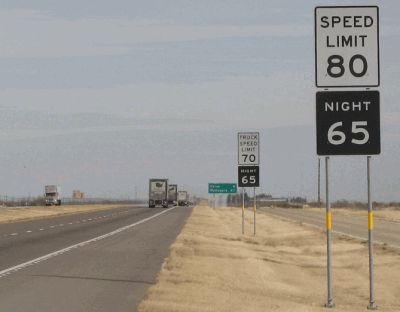
If you have a lead foot, then you’ll love this news.
First, if you hadn’t heard already, the Legislature earlier this year approved– and the governor signed– a bill that would raise the statutory maximum speed limit for state highways to 75 mph (excluding, of course, the existing 80 mph speed limit on some sections of I-10 and I-20 out in West Texas.) Texas now joins all but a handful of states west of the Mississippi with a 75 mph top speed. The limit can only be increased on roads where an engineering study determines that it’s safe to do so, but if past practice holds true, that should be the majority of roads that are currently capped at 70 mph.
Even better, the bill finally eliminates the matrix of speed limits for daytime/nighttime and cars/trucks. All speed limits will now apply to all vehicles at all times. Texas was the only state to still have a different nighttime limit and one of the few with a separate limit for trucks.
The new law takes effect September 1st. A separate effort to increase the maximum speed to 85 mph died.
More recently, the speed limit on the northern arc of Loop 410 has gone up from 60 mph to 65 mph. With the recent completion of construction to widen the freeway to 10 lanes, TxDOT completed a speed study that showed the 85th percentile speed being 65 mph, so in accordance with agency engineering guidelines, TxDOT asked the City of San Antonio to officially increase the speed limit to 65 mph north of US 90. Signs went up this past week.
I also recently noticed that the speed limit along Loop 1604 south of Braun Rd. increased from 55 mph to 60 mph.
